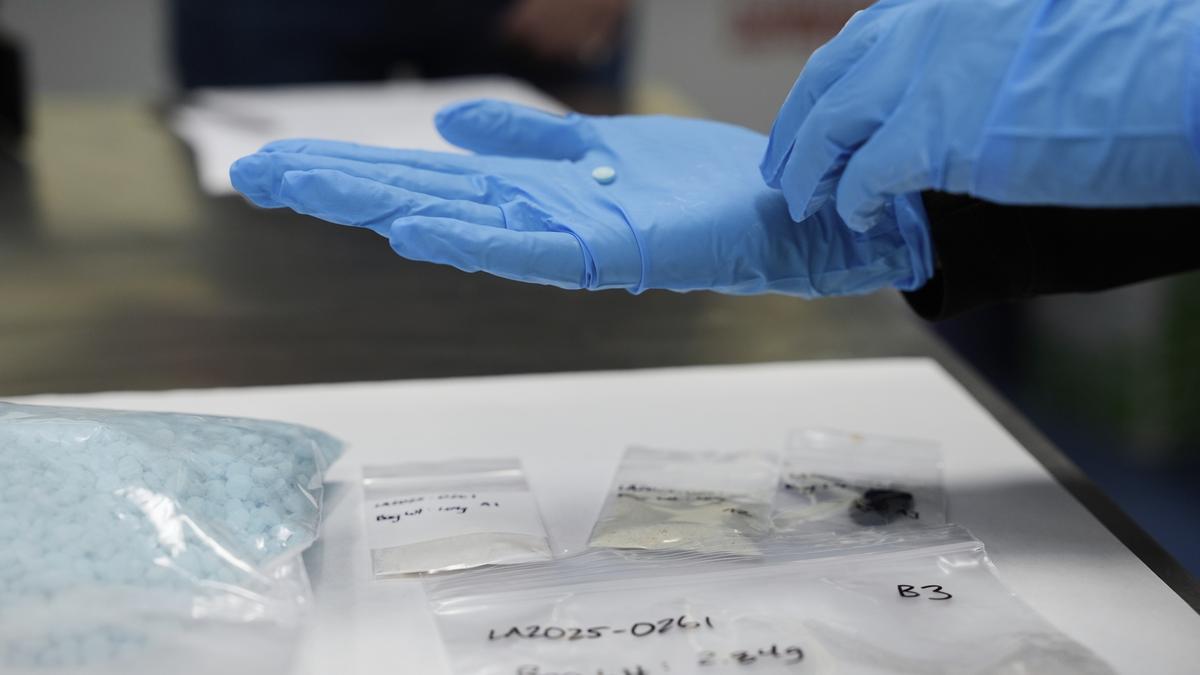Fentanyl Blacklist

- 24 Sep 2025
In News:
The United States has intensified its global campaign against fentanyl, a powerful synthetic opioid responsible for tens of thousands of overdose deaths annually. In its latest narcotics control measures, the U.S. has imposed visa bans on Indian business executives allegedly linked to the trafficking of fentanyl precursor chemicals, reflecting growing scrutiny of global supply chains originating in Asia.
Background: The Major’s List and India’s Inclusion
- In the latest “Major’s List” submitted to the U.S. Congress, President Donald Trump identified 23 countries as major sources or transit hubs for illicit drugs — particularly fentanyl — posing a threat to American citizens.
- The list includes India, Pakistan, China, and Afghanistan, among others. While inclusion does not imply failure in counter-narcotics efforts, it highlights each nation’s role in the production or transit of controlled substances and precursor chemicals.
- Countries such as Afghanistan, Bolivia, Myanmar, Colombia, and Venezuela were categorized as having “failed demonstrably” to meet international drug-control obligations.
Understanding Fentanyl:
Fentanyl was first synthesized in the 1960s for legitimate medical use as a potent painkiller. However, illicitly manufactured variants now dominate the U.S. illegal drug market.
- It is 50 times stronger than heroin, and just 2 milligrams can be fatal, as it suppresses the brain’s respiratory centers.
- Between August 2023 and August 2024, more than 57,000 Americans died of opioid overdoses, primarily linked to fentanyl.
- In 2022, the U.S. Drug Enforcement Administration (DEA) seized enough fentanyl to deliver 379 million lethal doses—enough to kill the U.S. population.
The crisis has been termed the “opioid epidemic”, driving unprecedented public health and security responses in the U.S.
Fentanyl Precursors and the Challenge of Regulation
- Unlike plant-based drugs such as heroin or cocaine, fentanyl is lab-synthesized from chemical precursors like N-phenethyl-4-piperidone (NPP) and 4-anilino-N-phenethylpiperidine (4-ANPP).
- These compounds have legitimate pharmaceutical and industrial uses, complicating global regulatory oversight. Small quantities of these chemicals can yield large volumes of fentanyl, and they are easily concealed in international shipments through mislabelling or false customs declarations.
- This has made it difficult for authorities to distinguish between lawful trade and diversion into illicit production networks.
Global Fentanyl Supply Chain
The global fentanyl network involves multiple countries across different stages of production and distribution:
- China and India are key producers of precursor chemicals, some of which are diverted to illegal channels.
- Mexican cartels synthesize fentanyl using these precursors, convert it into powder or counterfeit pills, and smuggle it into the U.S. through the southwest border.
This multi-tiered chain, combined with e-commerce and courier systems, has created a complex and decentralized trafficking web, challenging traditional interdiction mechanisms.
U.S. Domestic and Global Enforcement Measures
Domestically, the U.S. has expanded DEA operations, seizures, and public health initiatives to counter the crisis:
- Nationwide naloxone distribution to reverse overdoses in emergencies.
- Public awareness campaigns warning of counterfeit prescription pills laced with fentanyl.
- Enhanced treatment and rehabilitation programs to curb addiction and demand.
Internationally, Washington has combined criminal prosecution, trade measures, and sanctions to curb the flow of fentanyl and its precursors.
- In February 2025, additional tariffs were imposed on imports from China, Canada, and Mexico to pressure stronger enforcement; these were later suspended for Canada and Mexico after improved border controls.
- The U.S. has also sought to align global chemical control frameworks through the UN and bilateral agreements.
India’s Position
India, while listed as a “major drug transit or producing country,” has not been accused of state complicity. The issue primarily involves private firms and individuals engaged in illicit chemical exports. Indian authorities are expected to strengthen precursor control mechanisms, enhance customs surveillance, and ensure regulatory compliance within the pharmaceutical and chemical industries.
The episode underscores India’s dual challenge — balancing its role as a legitimate pharmaceutical exporter while preventing misuse of chemical manufacturing capacity.
Semiconductor Designers Power India’s Chip Dreams

- 24 Sep 2025
In News:
India’s semiconductor ecosystem is witnessing a transformative shift — from being a consumer-driven electronics market to an emerging design and manufacturing hub. While the country’s large-scale semiconductor fabrication projects are still in early stages, the chip design sector is already thriving, positioning India as a critical player in the global semiconductor value chain.
Policy Framework: Semicon India Mission
The turning point came in 2021, when the Government of India launched the ?76,000 crore Semicon India Programme, aimed at developing India into a global hub for electronics design and manufacturing.
- Manufacturing Push:The mission provides 50% capital support for semiconductor fabrication (fab) and assembly, testing, marking, and packaging (ATMP/OSAT) facilities, with states adding 20–25% additional incentives.
- Ten major projects have been approved across Gujarat, Punjab, Uttar Pradesh, Odisha, Andhra Pradesh, and Assam.
- Notably, Micron’s ?22,500 crore ATMP facility in Gujarat is under construction and expected to begin operations in 2024.
- Design Support:The Design Linked Incentive (DLI) and Chips to Startup (C2S)programmes aim to nurture a new generation of semiconductor designers.
- The C2S initiative provides free access to high-end Electronic Design Automation (EDA) tools from Siemens, Cadence, and Synopsys, while targeting the training of 85,000 engineers in five years.
India’s Edge in Semiconductor Design
- India today accounts for 20% of the global semiconductor design workforce, hosting around 1.25 lakh chip designers who develop nearly 3,000 chips annually.
- Multinational firms like NVIDIA, Intel, AMD, and Qualcomm run large R&D operations from India, spread across Bengaluru, Hyderabad, Pune, and Noida.
- Even as the world faces a projected shortage of one million chip designers by 2030 (Deloitte), India’s deep talent pool offers a natural advantage.
- The country produces over 8 lakh engineering graduates annually, with around 5.7 lakh enrolled in electronics and related disciplines (2021–22).
Academia–Industry Collaboration: Bridging the Gap
- Despite government efforts, experts underline a persistent disconnect between academia and industry. Indian industries invest only 0.4% of profits in academic R&D, compared to 5–6% in the U.S. and South Korea.
- Strengthening collaboration — through joint research, funded Ph.D. programs, and internship pipelines — is essential to make graduates industry-ready and sustain innovation.
- Institutions like IITs, IISc, and IIITs have begun partnerships with leading toolmakers such as Synopsys, Lam Research, and Cadence to enable frontier-level projects at sub-10 nanometer design nodes.
Economic and Strategic Implications
- High-Value Employment: Semiconductor jobs have a multiplier effect of 6.7, driving indirect employment in allied sectors.
- Export Potential: Electronics exports are projected to quintuple by 2026, narrowing India’s trade deficit.
- Strategic Autonomy: Domestic chip capacity reduces dependence on foreign suppliers, vital for defence, telecom, and automotive sectors.
- Innovation Push: With rising patent filings and homegrown IP, India is consolidating its role in the global tech value chain.
Red-Necked Phalarope

- 24 Sep 2025
In News:
In a notable development for ornithology and biodiversity conservation, the Red-necked Phalarope (Phalaropuslobatus), a rare migratory shorebird, has been sighted for the first time at the Nanjarayan Bird Sanctuary near Tiruppur, Tamil Nadu.
About the Red-Necked Phalarope
The Red-necked Phalarope is a small, migratory wader renowned for its unique feeding behavior and striking breeding plumage.
- Distinctive Feeding Behavior:It is known for its characteristic habit of spinning rapidly in circles on the water surface to stir up small invertebrates and plankton, which it then feeds upon.
- Physical Features:During the breeding season, the bird exhibits chestnut-red plumage extending from behind the ear to the sides of the neck — a feature that gives it its name.
Unusually among birds, the female is more brightly coloured than the male, and the species displays polyandrous behaviour (females mate with multiple males), with males incubating the eggs and caring for the chicks.
Distribution and Habitat
The Red-necked Phalarope has a circumpolar distribution, breeding in boreal and tundra zones between 60° and 70° latitude, across regions such as the Arctic coasts, Aleutian Islands, and northern Britain.
- During migration and the non-breeding season, it spends much of its time at sea, especially across:
- The Arabian Sea,
- Waters off central-west South America, and
- The central Indonesian to western Melanesian regions.
The recent sighting at Nanjarayan Bird Sanctuary — a vital inland wetland ecosystem — highlights the site’s growing importance as a stopover for migratory shorebirds along the Central Asian Flyway.
Conservation Status
- IUCN Red List:Least Concern
Despite being widespread globally, localized population declines have been observed due to habitat degradation, pollution, and climate-induced changes in migratory routes.
‘One-In, One-Out’ Migration Scheme
- 24 Sep 2025
In News:
- An Indian national has become the first person to be deported from the United Kingdom to France under the newly launched “one-in, one-out” migration scheme, part of the UK–France Returns Treaty.
- The deportation marks the beginning of a new bilateral arrangement aimed at curbing illegal cross-Channel migration and dismantling human smuggling networks operating between the two countries.
Background and Context
- The deported individual reportedly arrived in the UK illegally via the English Channel in early August 2025 aboard a small boat — one of the most common routes used by irregular migrants. He was subsequently detained and later flown from Heathrow to Paris on an Air France flight, under the provisions of the UK–France returns framework.
- The UK Home Office confirmed that upon arrival in France, the individual would be offered a voluntary, paid-for return to his home country. If he declines, he could face enforced deportation.
- The deportation comes amid a broader crackdown on illegal immigration in the UK, with reports indicating a sharp rise in Indian nationals detained in British immigration centres in recent months.
About the ‘One-In, One-Out’ Scheme
The “one-in, one-out” scheme is a bilateral deportation and migration management arrangement between the United Kingdom and France.
- Objective: To deter illegal small-boat crossings across the English Channel and disrupt human trafficking networks.
- Mechanism: For every illegal migrant returned by the UK to France, the UK will accept one legal asylum seeker from France — hence the name “one-in, one-out.”
- Implementation Period:August 2025 to June 2026, operating as a pilot programme subject to review.
- Provisions:
- Fast-track deportations for illegal entrants.
- Voluntary return option with financial assistance for deported migrants.
- Judicial oversight allowing courts to review last-minute appeals swiftly.
Significance of the Agreement
- Border Security: Strengthens the UK’s capacity to manage and deter illegal migration.
- International Cooperation: Demonstrates growing cross-border coordination between the UK and France on migration governance.
- Policy Shift: Reflects a move towards reciprocal responsibility in handling irregular migration.
- Political Impact: Reinforces the UK government’s tough stance on illegal immigration while maintaining humanitarian commitments.
Androth Anti-Submarine Warfare Ship
- 24 Sep 2025
In News:
- The Indian Navy has commissioned INS Androth, an indigenously built Anti-Submarine Warfare Shallow Water Craft (ASW-SWC), marking a significant milestone in strengthening India’s maritime security and self-reliance in defence production.
- Built by Garden Reach Shipbuilders & Engineers (GRSE), Kolkata, INS Androth is the second vessel in a series of eight ASW-SWCs being developed for the Navy.
Strategic Significance
- Named after Androth Island in the Lakshadweep archipelago, the ship’s designation underscores India’s commitment to safeguarding its maritime frontiers in the Arabian Sea and ensuring the security of critical sea lanes around the island territories.
- The induction comes at a time of growing Chinese naval presence in the Indian Ocean Region (IOR), adding a crucial layer of deterrence and surveillance to India’s coastal defence network.
Design and Capabilities
- INS Androth is designed for anti-submarine operations in shallow waters, coastal security patrols, and escort missions.
- It is 77 metres long and powered by diesel engine–waterjet propulsion, providing superior maneuverability in littoral and near-shore environments.
- Key onboard systems include:
- Advanced indigenous sonar and sensor suites for submarine detection and tracking.
- Lightweight torpedoes and ASW rockets for engaging underwater threats.
- 80% indigenous components, aligning with the ‘Aatmanirbhar Bharat’ initiative to reduce import dependence in defence production.
Operational Role
- The ship will primarily operate along India’s western seaboard, particularly around Lakshadweep, where it will conduct surveillance and deterrence missions against sub-surface threats.
- Its shallow-water design allows it to access areas that larger vessels cannot, enhancing the Navy’s reach in coastal and island territories.
